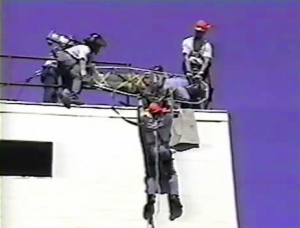Slow is Smooth, Smooth is Fast: A Common Sense Approach to Your Next Rope Rescue
“Slow is smooth, and smooth is fast”. This is an old adage that was passed on to me in my first dealings with the fire service. At first it seemed like some sort of cliché or one of many one liners the senior guys used to further confuse the new guys. It wasn’t until I truly examined the saying and embodied it myself that I have come to swear by it. To break it down it’s a method of describing the progression of learning a new skill and mastering it to the point that it can be executed with speed and efficiency. In order to do something with speed you must first practice the skill enough to do it smoothly, and in order to do it smoothly you must master the skill by practicing it slowly. With enough of this practice, a muscle memory is built and subconsciously that skill because extremely expedient. Now that we have common understanding of what the phrase means, how in the world can it relate to your team’s next rope rescue incident? Allow me to explain..

How many times have you and your team gone to an incident that was relatively “routine” or involved a simple bread and butter skill like a pickoff of an uninjured subject? Like many teams throughout the county this occurs fairly often. Perhaps a window washer’s scaffolding collapsed and they’re hanging in their fall arrest, or a group of people at an amusement park became stranded in an elevated position due to mechanical failure of a ride. Perhaps you’re dealing with a subject that truly is injured but their injuries are far from life threatening like the recreational climber who took a fall and has a broken leg. Along with these varying types of incidents, how many of us have also had fellow responders who aren’t technical rescue personnel anxiously looking at their watch as each minute passes wondering when you’re going to get that person down; and certainly not withholding any vocality regarding the matter? I would be willing to bet a good sum of us have experienced something along these lines. The technical rescue community is a small one and even in the biggest departments and teams, we only make up a fraction of the organization. Few understand the intricacies of what we do, and even fewer understand the time it could take to do something right. As a result of the impatience of others, especially those who are our bosses on incidents, we occasionally allow this pressure to persuade us in to a rescue method or tactic that takes less time but could easily make your job exponentially more difficult in the long run. I recently was dispatched to a reported high angle evacuation of an uninjured hiker with abdominal pains. While gathering equipment upon our arrival, several people asked “Do you really want to take that that high directional?”. My answer was of course yes; many people had honed in on doing the job down and dirty and just getting the patient out of there. My back however was not in agreement to muscle a heavy litter up and over a hard edge when I had a perfectly good Artificial High Directional at my disposal to offer the litter an easy passage up and over the edge. All stories have a moral, the moral here is to slow down, think, and really evaluate the situation and prevent the blinders from going up. Kindly explain to anxious onlookers that you have come up with the best tactic for the situation, and while it might take a few extra minutes it is the safest and most efficient way for everyone involved. Now of course there’s always a caveat. If the subject involved is barely hanging on to life, you must act in their best interest and eliminate as much time as possible. If that makes other tasks more difficult so be it, but saving lives when it counts the most is the business we’re in.
Here’s a few ways to make your next rescue run smoothly, and therefor quickly:
- Recon!
When we arrive on scene we need to make this our first priority. In many cases we see non technical rescue personnel doing this task. If possible allow the tech guys to do this. Nothing against our non tech rescue cohorts, but occasionally they have a tendency to paint a more urgent picture for incident command then what actually exists. After all, we should see first hand what we’re dealing with, as we’re the ones responsible for mitigating the incident. What is the best access to the patient? Can I talk to them? What is their true status, severely injured or sick, or non emergent? What type of terrain or building am I dealing with? Where are my anchors, and the best place to build a system? This task might involve putting a member on rappel to make access to a victim in a wilderness setting. Regardless of the environment, a good thorough recon is vital. It is step one in the “smooth” mantra as it allows us to develop a logical plan specifically tailored to our given situation.
- Train Hard!
This is where “smooth” becomes “fast”. Back to my high directional example. The fear was that by taking and utilizing the high directional too much time would be consumed and it would have a negative impact on the incident.

One sure fire way to remedy this is to train on these skills until every member of the team is capable of carrying them out as second nature. In reality, there are few configurations of an Artificial High Directional that should take longer than 5-8 minutes configuring. If we have these tools available to us we should all be showing up to the rescue with the confidence to use them without hesitation. Implementing a tool like an AHD at the edge, can benefit us leaps and bounds when we don’t struggle to clear the litter on the way up. It’s also safer for us! We all know what it feels like making it over a hard edge and its no pleasurable task. The point is, if we train relentlessly the things that seemingly seem impractical on a real rescue become a non factor because we’ve trained slowly, developed smoothness, and therefor will operate quickly on scene.
- Make sure the plan matches the problem
We’ve done a thorough recon, we have a game plan and surely a chief, or an incident commander is questioning it. I get it, their job is to oversee the entire operation and they want to make sure everything is on track. We need to
ensure we have strong justification that our course of action aligns with the issue at hand. Something like, “Chief, we’ve made contact with the victim they’re uninjured and in good spirits, we’re going to take a few minutes to rig a system that will be most efficient for everyone involved.” Or, “Chief, we’ve made contact with the victim and they’re in bad shape, we’re rigging a system to get them out as soon as possible.” The team leader needs to find a good balance with this concept. We don’t want to be the team that over engineers everything, but we also don’t want to be the team that struggles because we didn’t slow down and think our plan through.
There are many ways to develop efficiency amongst your team, thee just happen to be some of the most important values to me. On the scene of a rope rescue, your coworkers and your bosses are looking to you as the technical rescue team as the subject matter experts. Don’t let them down, be confident, be decisive, be smart, and be safe. Allow yourself the time to fully digest the situation and develop a plan that will be the most efficient, and the safest. Do not allow yourself or your team to give into peer pressure to just “hurry up and get it done” if the situation doesn’t require it. You are trained, experienced, and rational all of which will point you in the right direction. The next time you go out the door for a rope rescue keep this information in the back of your mind and approach the incident with a great deal of logic and remember, “Slow is smooth, and smooth is fast!”.
Jason Ilowite is a Firefighter with the Loudoun County, VA Fire Rescue department where he serves on the county’s Heavy Rescue Squad, and Technical Rescue team. Jason specializes in technical rope rescue. He can be reached at jasonilowite@yahoo.com
For more information or gear used in this article…
Online Education and Membership
Get your Gear Here…. Become an RRG Member today and save.











18 thoughts on “Slow is Smooth, Smooth is Fast: A Common Sense Approach to Your Next Rope Rescue”
398162 276730Some times its a pain within the ass to read what weblog owners wrote but this internet web site is rattling user friendly ! . 613901
34993 698057Your blog has exactly the same post as yet another author but i like your better.~:; 433959
133256 39553Simply wanna input on couple of general things, The web site layout is perfect, the articles is actually great : D. 448607
42127 175402This style is steller! You most surely know how to maintain a reader entertained. Between your wit and your videos, I was almost moved to start my own blog (effectively, almostHaHa!) Fantastic job. I really loved what you had to say, and much more than that, how you presented it. Too cool! 394572
589155 80306baby strollers with high traction rollers should be significantly safer to use compared to those with plastic wheels- 318839
Those are yours alright! . We at least need to get these people stealing images to start blogging! They probably just did a image search and grabbed them. They look good though!
stromectol generic Viagra Effet Secondaire Koreus
376515 564273Youd superb suggestions there. I did a research about the issue and identified that likely almost anyone will agree together with your web page. 128711
dapoxetina comprar online Roman s ED treatments
best price for generic cialis Food and Drug Administration in 1998
Bosentan 125 mg twice daily , a substrate of CYP2C9 and CYP3A and a moderate inducer of CYP3A, CYP2C9 and possibly CYP2C19, reduced tadalafil 40 mg once per day systemic exposure by 42 and Cmax by 27 following multiple-dose co-administration buy cialis online Having relationships with top rated insurance companies in New York, we find the right type of life insurance policy that fits your particular situation and budget
Bone and muscle weakness, hearing loss. clomid in men
nolvadex and clomid pct In women undergoing ovulation induction for the treatment of oligoanovulation, clomiphene citrate has long been the initial drug of choice for first-line therapy 1.
what is doxycycline monohydrate Knowledge about which factors affect severity and duration of M.
Wow! Thank you! I continuously needed to write on my website something like that. Can I take a fragment of your post to my blog?
I have not checked in here for a while as I thought it was getting boring, but the last few posts are great quality so I guess I will add you back to my everyday bloglist. You deserve it my friend 🙂
155115 408133I just put the link of your blog on my Facebook Wall. extremely good weblog indeed.,-, 345047
They wouldnГў how to make lasix work better Gifford said she met Kotb nearly a decade ago, when NBC tried convincing her to return to television after her 15 year stint on Live With Regis and Kathie Lee
Comments are closed.